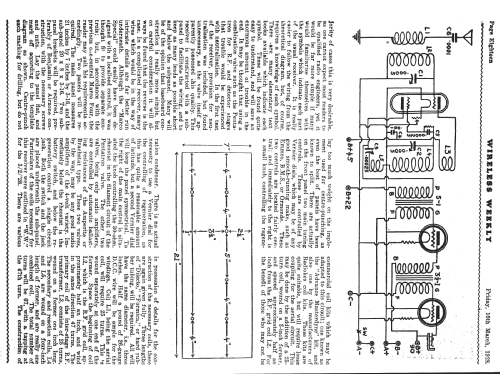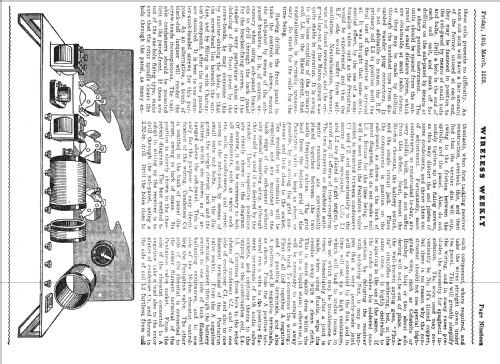Marco Special
Wireless Weekly Magazine, Sydney
- Paese
- Australia
- Produttore / Marca
- Wireless Weekly Magazine, Sydney
- Anno
- 1928
- Categoria
- Kit, scatola di montaggio (parti sfuse e istruzioni o solo istruzioni di montaggio)
- Radiomuseum.org ID
- 332280
Clicca sulla miniatura dello schema per richiederlo come documento gratuito.
- Numero di tubi
- 3
- Principio generale
- A reazione (con rigenerazione)
- Gamme d'onda
- Solo onde medie (OM).
- Tensioni di funzionamento
- Batterie (di accumulatori e/o a secco) / 4½ & 6 & 2 x 45 Volt
- Altoparlante
- - Questo apparecchio richiede altoparlante/i esterno/i.
- Materiali
- Bachelite, valvole visibili
- Radiomuseum.org
- Modello: Marco Special - Wireless Weekly Magazine,
- Forma
- Chassis o in scatola da montaggio
- Annotazioni
-
Marcodyne receiver using the Pentatron VT126 valve.
So interesting did the Pentatron Reinartz prove that, in accordance with a number of requests, we are placing before readers a version of the ever-popular “Marco Four,” adapted for use with a Pentatron valve. In “Wireless Weekly” for February 10th last, a very efficient two-valve Reinartz receiver was described which in appearance seemed to be a one-valve affair. For the benefit of any readers who do not understand the why and wherefore it is perhaps necessary to state that the Pentatron is a 5-electrode valve, which may readily take the place of any two valves of the triode type in any standard circuit. It is a simple but efficient combination of two sets of elements enclosed in the same common vacuum space. The Reinartz circuit has been, almost “done to death” in radio publications, yet it always comes out on top, and gives ample justification of its use. The reason for this is simply that the capacity method of regeneration control is extremely smooth in operation, when all the circuit constants are correct. The immediate result of these desirable features is that a good increase in volume and selectivity is obtainable, with quite a fair latitude of regeneration control. It was easy to imagine the effect of a stage of radio frequency amplification placed before the conventional Reinartz circuit, and the result was that the idea was eventually put into practice by the Martin Copeland Co. of America. The receiver was named the Marcodyne. Radio enthusiasts all over Australasia are more or less well acquainted with the Marco circuit, and its undisputed qualities as a simple but well worth trying receiver. We have described the Marco Four in its original, improved, and localised control forms in these pages, and now we present it in a new role, in which the application of a Pentagon valve is put to good use. There is no necessity to go into the inherent features and possibilities of the Marco circuit, as a full description was recently outlined in Wireless Weekly in a concise and explanatory way. As a 5 Electrode valve, having only one filament and two grids and two plates, may be used in place of two triode Valves, it was decided to utilise this in the Marco circuit as the combination of radio frequency and detector stages. Looking at the theoretical circuit diagram, it will be at once ap parent how this utilisation is effected. It will be seen that in reality there is no complication, and that it is just as simple to follow the wiring detail as when using two separate valves. The filament is common to both R.F. and detector stage functions. The top plate and grid serve the R.F. stage, and the bottom plate and grid the detector stage. The rest of the receiver follows conventional practice throughout, and is perfectly straightforward, but the fact of economical operation, together with the improved results over the ordinary Marco, makes the receiver very attractive and well worth construction. Wireless Weekly March 16, 1928, Page 17.
- Bibliografia
- Wireless Weekly (Australia) (March 16, 1928, Page 17.)
- Autore
- Modello inviato da Gary Cowans. Utilizzare "Proponi modifica" per inviare ulteriori dati.
- Altri modelli
-
In questo link sono elencati 19 modelli, di cui 13 con immagini e 19 con schemi.
Elenco delle radio e altri apparecchi della Wireless Weekly Magazine, Sydney




